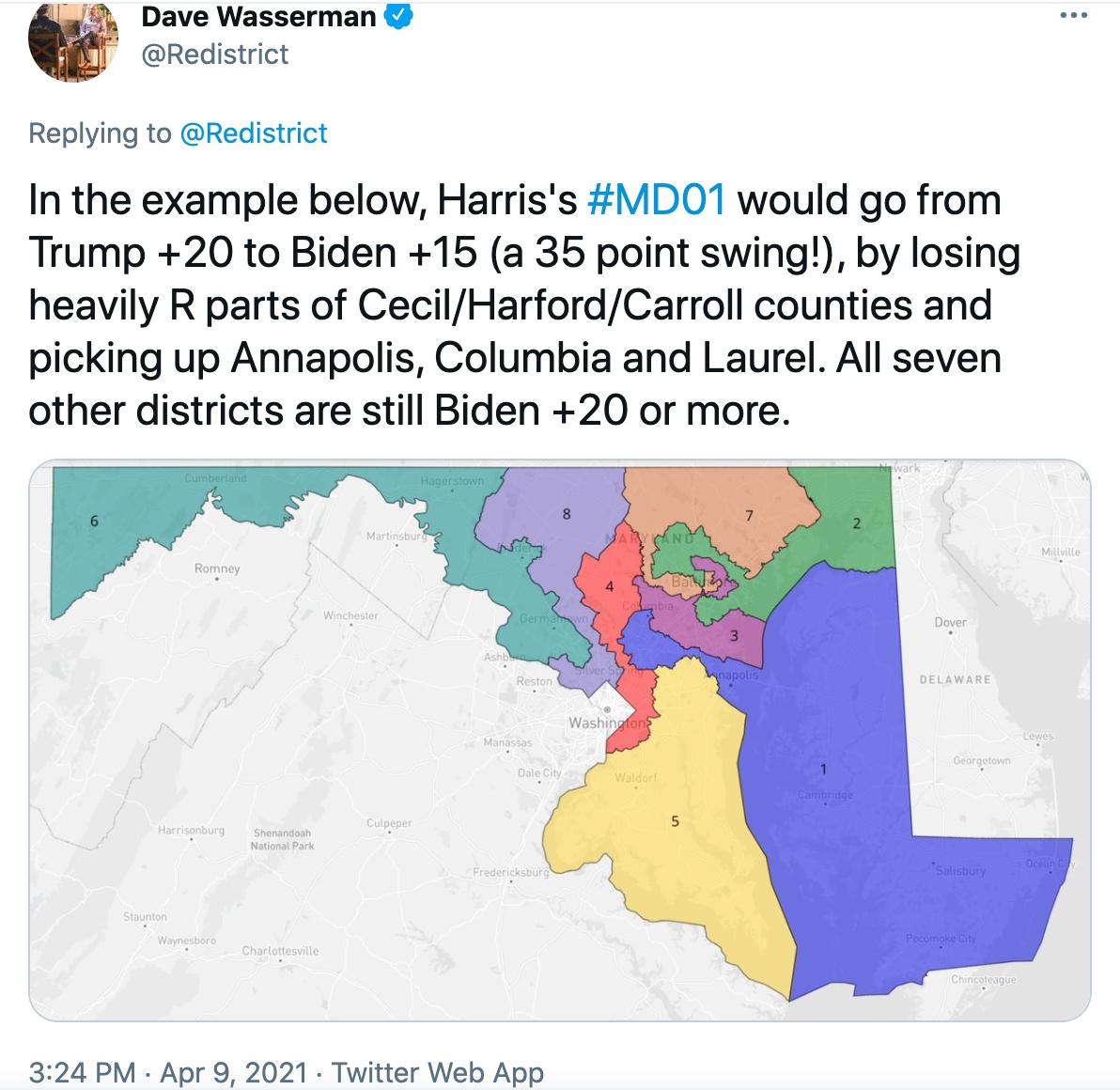After turning the state’s Sixth Congressional District blue following the 2010 Census, Maryland Democrats could set their sights on the state’s sole remaining Republican lawmaker, Rep. Andy Harris, during the congressional redistricting that will follow the 2020 Census.
A map drawn by one political analyst shows it would be relatively easy for Democratic state lawmakers to shut out Maryland Republicans from Congress by shifting the boundaries of the state’s eight congressional districts.
David Wasserman, writing in The Cook Political Report (subscription required), said the map would result in a 35-point leftward swing for the First District. The new district would have voted for Joe Biden by 15 points in 2020; current First District voters chose Donald Trump by 20 points in the 2020 presidential race.
Wasserman is House Editor for The Cook Political Report, where he is responsible for analyzing U.S. House races and is recognized as one of the nation’s top election forecasters. He also is a contributor to NBC News.
Maryland’s other seven congressional districts would remain overwhelmingly Democratic with his map, voting for Biden by at least 20 points, Wasserman wrote in his Maryland redistricting preview and on Twitter.

Wasserman developed his map using Dave’s Redistricting App, which allows users to explore congressional redistricting options.
One Democrat who has filed to challenge Harris in the First District noted Wasserman’s analysis, but suggested opposition to such a big change.
On her campaign website, Heather Mizeur, a former state delegate and gubernatorial candidate who lives in Kent County, wrote:
“We don’t want a gerrymandered district. We want a fair district. The right answer in how it gets drawn at the end of the day is somewhere in between these extreme shifts.
“What we know for sure is that the district will be redrawn, it will get more competitive, and we are and will continue to be the campaign best positioned to defeat Andy Harris when it happens.”
The Maryland map currently in use (below) was approved in 2011 using data from the 2010 Census. A legal challenge to that map ended in 2019 when the U.S. Supreme Court ruled that the courts have no role in partisan gerrymandering claims.
Statewide_reducedPartisan gerrymandering of congressional districts can have dramatic effects on the party control of the House.
In the Atlas of Redistricting, Wasserman and others writing at FiveThirtyEight looked at congressional districts based on several different factors.
Their analysis showed that if districts were gerrymandered to favor Democrats, the party would be expected to have 251 seats in the House compared to 184 for Republicans. If districts were gerrymandered to favor Republicans, the GOP would be expected to have 264 seats to 171 for Democrats.
The U.S. Census Bureau, citing the COVID-19 pandemic, announced in February that redistricting data would be released to all states by Sept. 30, six months later than its April 1 deadline.
The bureau will deliver apportionment counts (which determine how many representatives each state will have) to the president by April 30, four months later than normal. Maryland is expected to maintain its eight seats in the U.S. House of Representatives.



Gren Whitman says
I remember when Maryland’s House delegation consisted of four Dems and four GOPs, and not one of the GOPs was reprehensible.
Steve Beard says
As a hopeful future resident of Chestertown, there is nothing I would like better than to see Andy Harris gone, but I have to say that the proposed redistricting shown exhibits extreme gerrymandering, especially districts 1, 2, 4, 7 and 8. I am a Democrat but I believe that RDs should be as contiguous as possible. RD 1 right now is too large and convoluted to reflect the political leanings of the whole district.